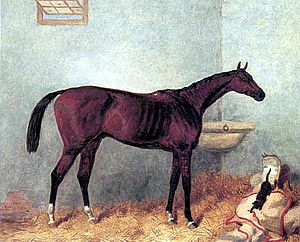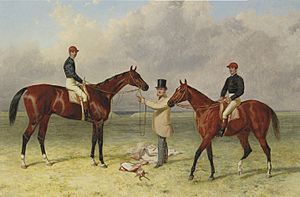Lord Lyon (horse) facts for kids
Quick facts for kids Lord Lyon |
|
|---|---|

Lord Lyon by Harry Hall
|
|
| Sire | Stockwell |
| Grandsire | The Baron |
| Dam | Paradigm |
| Damsire | Paragone |
| Sex | Stallion |
| Foaled | 1863 |
| Country | United Kingdom of Great Britain and Ireland |
| Colour | Bay |
| Breeder | General Mark Pearson |
| Owner | 1) General Mark Pearson (1863–1876) Richard Sutton (lessee, 1865–1867) 2) Lord Rosebery and Clare Vyner (1876–c.1880) 3) John Winteringham (c.1881–1887) |
| Trainer | James Dover |
| Record | 21: 17-3-1 |
| Earnings | £18,700 ($127,825) |
| Major wins | |
| Troy Stakes (1865) Criterion (1865) Epsom Derby (1866) 2,000 Guineas Stakes (1866) St. Leger Stakes (1866) Craven Stakes (1867) |
|
| Honours | |
| Third English Triple Crown winner | |
Lord Lyon (1863–1887) was a famous British Thoroughbred racehorse. He became the third horse to win the English Triple Crown in 1866. This means he won three very important races: the Epsom Derby, the 2,000 Guineas Stakes, and the St. Leger Stakes.
Lord Lyon raced until he was four years old. He then retired in 1868 to become a breeding horse, called a stallion. He produced some good offspring, like the colt Minting and the filly Placida. Lord Lyon lived until 1887, when he was put down due to poor health.
Contents
About Lord Lyon
Lord Lyon was born in 1863 at Oakley Hall in Northamptonshire, England. This was the farm of General Mark Pearson, who bred horses. Lord Lyon's father was a famous horse named Stockwell. Stockwell had won the St. Leger and 2,000 Guineas races himself. He was also a top breeding stallion seven times.
Lord Lyon's mother was a horse named Paradigm. She wasn't a very famous racehorse. She only ran twice before getting injured. But Paradigm became a wonderful mother horse, known as a broodmare. She had 13 foals in total. Lord Lyon's full sister, Achievement, also won the St. Leger race in 1867. Another sister, Chevisaunce, had a daughter named Jannette who won the Epsom Oaks and St. Leger.
Lord Lyon was a bay horse, which means he was reddish-brown. He stood about 15.3 hands tall. He had four white "socks" on his legs. People said he was a bit "odd-shaped" but had strong bones. His jockey, Henry Custance, mentioned that Lord Lyon sometimes made a slight whistling sound when breathing. This was treated with a special procedure. Lord Lyon was known for being a very calm and gentle horse. His trainer, James Dover, called him "the quietest horse I have got."
Lord Lyon's Racing Career
During his racing years, Lord Lyon was leased by Richard Sutton. General Pearson still owned part of him. Lord Lyon had his first practice race, called a trial, in September 1864. He was still very young, just a yearling. General Pearson liked to test his young horses early to see how good they were. Lord Lyon won 17 of his 21 races during his career. He retired from racing when he was four years old.
Early Trials (1864–1865)
Lord Lyon's first trial race was on September 10, 1864. He raced against a two-year-old filly named Jezebel. Even though he was younger, Lord Lyon only lost by a small amount. This showed he had great potential. He had another trial in April 1865, finishing third. This race seemed to upset him a bit.
After some more training, Lord Lyon had two more trials in August 1865. He easily beat his older half-sister, Gardevisure, in both. He won these races without even having to gallop very fast.
Two-Year-Old Season (1865)
Lord Lyon's first official race was the Champagne Stakes at Doncaster. He finished in a dead heat with another colt named Redan. A dead heat means both horses crossed the finish line at the exact same time. Lord Lyon's team decided not to race again to break the tie, so Redan was given the win. People were very impressed with Lord Lyon's performance.
Later that year, Lord Lyon won the Troy Stakes at Newmarket. He beat Mr. Pitt by a small margin. At his last race as a two-year-old, he won the Criterion by two lengths.
Triple Crown Year (1866)
As a three-year-old, Lord Lyon was a top favorite to win the Derby. He started his season by winning the 2000 Guineas race at Newmarket. He beat 14 other horses to take the win.
Then came the famous Epsom Derby race. Lord Lyon was the favorite among 25 horses. The race had many false starts, causing a delay. Lord Lyon started slowly but moved up steadily. He caught up to the leader, Redan. Then, another horse called the "Bribery Colt" suddenly pulled ahead. But Lord Lyon's jockey, Henry Custance, kept pushing. Lord Lyon showed amazing determination. He caught the Bribery Colt right at the very end, winning by just a head! It was a thrilling finish.
After the Derby, Lord Lyon raced at Royal Ascot. He finished second to Rustic in the Prince of Wales's Stakes.
In September, Lord Lyon went to Doncaster for the St. Leger Stakes. He faced Savernake again. Lord Lyon won by a head in what was called one of the most exciting races in years. This victory completed his Triple Crown win! He was only the third horse in history to achieve this amazing feat.
The day after his St. Leger win, he finished second in the Doncaster Cup. In October, Lord Lyon won two more races at Newmarket. He also had a special match race against Rustic. This time, Lord Lyon easily beat Rustic by 20 lengths, reversing his earlier loss.
Four-Year-Old Season (1867)
In March, Lord Lyon won the Trial Stakes at Northampton very easily. He also won the Craven Stakes and two other races at Newmarket in April. At Ascot, he won the Biennial Stakes by a large margin of 12 lengths. He also won the Stockbridge Cup.
Lord Lyon's last race was the Queen's Plate in Lincoln. He lost by a head to Rama. After this, Lord Lyon retired from racing in 1868. General Pearson became his full owner again.
Life as a Breeding Stallion
Lord Lyon's career as a breeding stallion was a bit complicated. He moved to many different farms over 10 years. In 1868, he started his new job at Neasham Hall Stud Farm. He bred with 45 mares in his first year. He later moved to Hurstbourne Park and then to Shepherd's Bush in London.
In 1876, Lord Lyon was sold to Lord Rosebery and Clare Vyner for £4,500. He moved to Rosebery's Crafton Stud. Lord Lyon had some ongoing issues with his feet and legs. This made it harder for him to be a successful breeding horse. One expert noted that his ankles and feet were too small.
In the early 1880s, some people thought about putting Lord Lyon down because of his health. But a man named John Winteringham saved him. Winteringham moved Lord Lyon to Croft Stud. After his son Minting became famous, Lord Lyon was advertised for breeding again. He lived in Yorkshire until he passed away on April 12, 1887, at 24 years old.
Notable Offspring
Lord Lyon produced some important racehorses:
| Born | Name | Gender | Major Wins/Achievements |
|---|---|---|---|
| 1874 | Placida | Mare | Epsom Oaks (1877) |
| 1874 | Touchet | Stallion | Won or placed in several big races. He also became a father to other racehorses. |
| 1883 | Minting | Stallion | Grand Prix de Paris (1886) |
Images for kids




